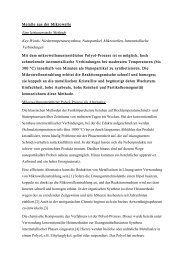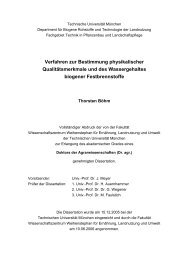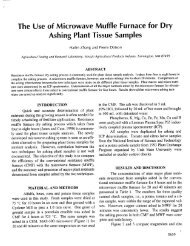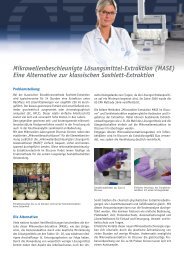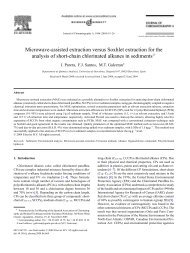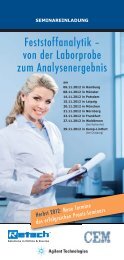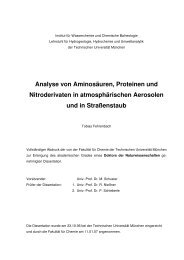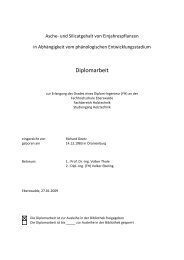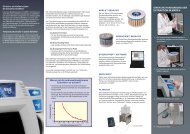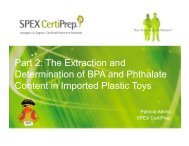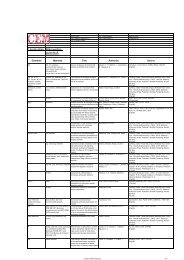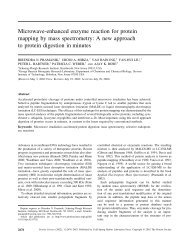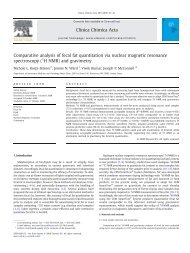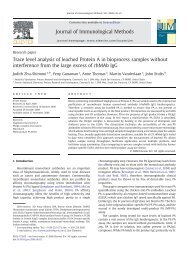Tandem Bis-aldol Reaction of Ketones: A Facile One-Pot Synthesis ...
Tandem Bis-aldol Reaction of Ketones: A Facile One-Pot Synthesis ...
Tandem Bis-aldol Reaction of Ketones: A Facile One-Pot Synthesis ...
Create successful ePaper yourself
Turn your PDF publications into a flip-book with our unique Google optimized e-Paper software.
<strong>Tandem</strong> <strong>Bis</strong>-<strong>aldol</strong> <strong>Reaction</strong> <strong>of</strong> <strong>Ketones</strong>: A <strong>Facile</strong><br />
<strong>One</strong>-<strong>Pot</strong> <strong>Synthesis</strong> <strong>of</strong> 1,3-Dioxanes in Aqueous<br />
Medium<br />
Vivek Polshettiwar and Rajender S. Varma*<br />
Sustainable Technology DiVision, National Risk Management<br />
Research Laboratory, U. S. EnVironmental Protection Agency,<br />
MS 443, Cincinnati, Ohio 45268<br />
Varma.rajender@epa.goV<br />
ReceiVed June 21, 2007<br />
A novel tandem bis-<strong>aldol</strong> reaction <strong>of</strong> ketone with paraformaldehyde<br />
catalyzed by polystyrenesulfonic acid in aqueous<br />
medium delivers 1,3-dioxanes in high yield. This one-pot,<br />
operationally simple microwave-assisted synthetic protocol<br />
proceeds efficiently in water in the absence <strong>of</strong> organic<br />
solvent, with excellent yield.<br />
Dioxane rings are common structural motifs in numerous<br />
bioactive molecules such as (+)-Dactylolide (a cytotoxic agent), 1<br />
derivatives <strong>of</strong> 2-substituted-1,3-dioxanes (antimuscarinic agents), 2<br />
and (+)-SCH 351448 (a novel activator <strong>of</strong> low-density lipoprotein<br />
receptor promoters). 3 A variety <strong>of</strong> biologically active<br />
molecules have been identified from libraries <strong>of</strong> diverse, natural<br />
product-like 1,3-dioxanes. 4 Recently 1,3-dioxane derivatives<br />
have been found to be effective modulators for multidrug<br />
resistance. 5 Over the years, there has been a plethora <strong>of</strong> elegant<br />
methodologies developed independently for the synthesis <strong>of</strong><br />
these molecules. The acid-catalyzed condensation <strong>of</strong> olefins with<br />
aldehyde known as Prins reaction is generally used for these<br />
dioxane syntheses. 6 The major product <strong>of</strong> this reaction consists<br />
<strong>of</strong> tetrahydropyran, 1,3-dioxane, 1,3-glycol, or an unsaturated<br />
(1) Aubele, D. L.; Wan, S.; Floreancig, P. E. Angew. Chem., Int. Ed.<br />
2005, 44, 3485-3488.<br />
(2) Marucci, G.; Piero, A.; Brasili, L.; Buccioni, M.; Giardinà, D.; Gulini,<br />
U.; Piergentili, A.; Sagratini, G. Med. Chem. Res. 2005, 14, 274-296.<br />
(3) Chan, K.; Ling Y. H.; Loh, T. Chem. Commun. 2007, 939-941.<br />
(4) (a) Shang S.; Tan, D. S. Curr. Opin. Chem. Biol. 2005, 9, 248-258.<br />
(b) Wong, J. C.; Sternson, S. M.; Louca, J. B.; Hong, R.; Schreiber, S. L.<br />
Chem. Biol. 2004, 11, 1279-1291. (c) Pinilla, C.; Appel, J. R.; Borras E.;<br />
Houghten, R. A. Nat. Med. 2003, 9, 118-122.<br />
(5) Schmidt, M.; Ungvari, J.; Glode, J.; Dobner, B.; Langner, A. Bioorg.<br />
Med. Chem. 2007, 15, 2283-2297.<br />
(6) Yang, N. C.; Yang, D. H.; Ross, C. B. J. Am. Chem. Soc. 1959, 81,<br />
133-136.<br />
7420 J. Org. Chem. 2007, 72, 7420-7422<br />
alcohol depending on the reaction conditions. 7 In fact, several<br />
groups have taken advantage <strong>of</strong> this transformation as an<br />
efficient approach to natural product targets. 8<br />
While dioxanes have great potential as a drug candidate, the<br />
synthetic protocol <strong>of</strong> this important molecule has been largely<br />
untapped. In view <strong>of</strong> our ongoing research effort devoted to<br />
the development <strong>of</strong> greener synthetic pathways for a range <strong>of</strong><br />
bioactive molecules, 9 herein, we report a novel tandem bis-<strong>aldol</strong><br />
reaction <strong>of</strong> ketones with paraformaldehyde catalyzed by polymersupported<br />
polystyrenesulfonic acid (PSSA) under microwave<br />
(MW) irradiation in aqueous media to yield 1,3-dioxanes<br />
(Scheme 1).<br />
SCHEME 1. <strong>Bis</strong>-<strong>aldol</strong> <strong>Reaction</strong> <strong>of</strong> Flavanone in Water<br />
We initially investigated the reaction <strong>of</strong> acetophenone with<br />
paraformaldehyde to establish the feasibility <strong>of</strong> our strategy to<br />
1,3-dioxane systems and to optimize the reaction conditions<br />
(Table 1).<br />
TABLE 1. Optimization <strong>of</strong> <strong>Reaction</strong> Conditions with Use <strong>of</strong> MW<br />
Irradiation<br />
entry catalyst solvent<br />
temp<br />
(°C)<br />
reaction<br />
time (min)<br />
yield<br />
(%)<br />
1 MeOH 100 60 NR<br />
2 clay MeOH 120 45 NR<br />
3 Nafion MeOH 120 45 NR<br />
4 AcOH 120 45 25<br />
5 TFA 120 45 81<br />
6 PSSA water 120 30 83<br />
7 PSSA water sonication 24 h NR<br />
First the reaction was conducted without any catalyst by using<br />
MW and no reaction (NR) was observed. Then montmorillonite-<br />
K10 (clay) and Nafion-H catalysts in methanol (MeOH) were<br />
tested and in both these conditions, little dehydrated product<br />
and no bis-<strong>aldol</strong> products were obtained. Acetic acid (AcOH)<br />
did catalyze the reaction, but the yield was very poor. However,<br />
trifluroacetic acid (TFA) and PSSA did efficiently catalyze this<br />
reaction and afforded high yields <strong>of</strong> the desired product.<br />
(7) (a) Fuson, R. C.; Ross W. E.; McKeever, C. H. J. Am. Chem. Soc.<br />
1938, 60, 2935-2936. (b) Lumma W. C.; Ma, O. H. J. Org. Chem. 1970,<br />
35, 2391-2393. (c) Jasti R.; Rychnovsky, S. D. J. Am. Chem. Soc. 2006,<br />
128, 13640-13648. (d) Barluenga, J.; Dieguez, A.; Fernandez, A.;<br />
Rodriguez F.; Fananas, F. J. Angew. Chem., Int. Ed. 2006, 45, 2091-2093.<br />
(e) Cho, Y. S.; Karupaiyan, K.; Kang, H. J.; Pae, A. N.; Cha, J. H.; Koh,<br />
H. Y.; Chang, M. H. Chem. Commun. 2003, 2346-2347.<br />
(8) (a) Adams, D. R.; Bhaynagar, S. D. <strong>Synthesis</strong> 1977, 661-672. (b)<br />
Snider, B. B. The Prins and Carbonyl Ene <strong>Reaction</strong>s. In ComprehensiVe<br />
Organic <strong>Synthesis</strong>; Trost, B. M., Ed.; Pergamon Press: Oxford, UK, 1991;<br />
Vol. 2, pp527-561.<br />
(9) (a) Polshettiwar, V.; Varma, R. S. Tetrahedron Lett. 2007, 48, 5649-<br />
5652. (b) Ju, Y.; Kumar, D.; Varma, R. S. J. Org. Chem. 2006, 71, 6697-<br />
6700. (c) Ju, Y.; Varma, R. S. J. Org. Chem. 2006, 71, 135-141. (d) Ju,<br />
Y.; Varma, R. S. Org. Lett. 2005, 7, 2409-2411. (e) Wei, W.; Keh, C. C.<br />
K.; Li, C.-J.; Varma, R. S. Clean Technol. EnViron. Policy 2005, 7, 62-<br />
69. (f) Kumar, D.; Chandra Sekhar, K. V. G.; Dhillon, H.; Rao, V. S.;<br />
Varma, R. S. Green Chem. 2004, 6, 156-157. (g) Yang, X. -F.; Wang,<br />
M.; Varma, R. S.; Li, C.-J. Org. Lett. 2003, 5, 657-660.<br />
10.1021/jo701337j CCC: $37.00 © 2007 American Chemical Society<br />
Published on Web 08/16/2007
In view <strong>of</strong> the emerging MW chemistry interest in aqueous<br />
reaction medium, 10 and in keeping with our emphasis on<br />
exploration <strong>of</strong> cleaner pathways, 9 we tried to develop greener<br />
reaction conditions and observed that PSSA efficiently catalyzed<br />
this reaction in water. Thus, we have developed an aqueous<br />
one-pot protocol for the tandem bis-<strong>aldol</strong> reaction <strong>of</strong> ketone<br />
with paraformaldehyde. To further define the scope <strong>of</strong> this<br />
reaction, a wide variety <strong>of</strong> ketones were evaluated for this<br />
cyclization reaction and the results are summarized in Table 2.<br />
Various ketones reacted efficiently with paraformaldehyde<br />
to afford the desired 1,3-dioxanes in good yield (entries 1-7).<br />
This approach establishes a convenient and flexible method to<br />
attach functional arms to indanone and flavanone (entries 8 and<br />
9) for further elaboration in synthetic design. The aliphatic<br />
ketones, however, afforded low yields (entries 10-12), which<br />
may be due to their unavoidable self-condensation. 1-Methyl-<br />
2-pyrrolidinone (entry 11) gave no product indicating the<br />
nonreactivity <strong>of</strong> amide carbonyl toward this reaction. The<br />
reaction is completed under conventional heating in an oil bath<br />
at the same temperature to afford comparable yields but requires<br />
an extended period <strong>of</strong> time, 4-5 h.<br />
It is noteworthy to mention that these reactions are working<br />
well in an aqueous medium without using any phase-transfer<br />
catalyst (PTC). This may be due to selective absorption <strong>of</strong><br />
microwaves by reactants, intermediates, and polar aqueous<br />
medium, 10 which accelerate the reaction even in the absence <strong>of</strong><br />
PTC. In most <strong>of</strong> the experiments, we observed that after<br />
completion <strong>of</strong> reactions, the phase separation <strong>of</strong> the desired<br />
product from the aqueous media occurs under hot condition,<br />
which facilitates isolation <strong>of</strong> the crude product by simple<br />
decantation instead <strong>of</strong> tedious extraction processes, thus reducing<br />
the use <strong>of</strong> volatile organic solvents for extraction. As exemplified<br />
by the reaction <strong>of</strong> flavanone with paraformaldehyde in PSSA/<br />
water, a distinct phase separation was exhibited (as shown in<br />
the graphical abstract).<br />
The mechanism <strong>of</strong> the similar cyclization reaction has been<br />
studied by Ross et al. in the synthesis <strong>of</strong> 1,3-dioxanes from<br />
alkene and aldehyde, 6 stereoaspects <strong>of</strong> which were then explored<br />
by Portoghese et al. 11 We postulate the following mechanism<br />
for the PSSA-catalyzed tandem bis-<strong>aldol</strong> reaction <strong>of</strong> ketone with<br />
paraformaldehyde in water (Scheme 2).<br />
SCHEME 2. Mechanism <strong>of</strong> the <strong>Bis</strong>-<strong>aldol</strong> <strong>Reaction</strong><br />
The reaction involved the addition <strong>of</strong> a protonated formaldehyde<br />
(generated by microwave exposure <strong>of</strong> paraformaldehyde<br />
with PSSA/water) molecule to ketone (enol) to form �-hydroxy<br />
(10) (a) Dallinger, D.; Kappe, C. O. Chem. ReV. 2007, 107, 2563-2591.<br />
(b) Iimura, S.; Manabe, K.; Kobayashi, S. Org. Biomol. Chem. 2003, 1,<br />
2416-2418.<br />
(11) Smissman, E. E.; Schnettler, R. A.; Portoghese, P. S. J. Org. Chem.<br />
1965, 30, 797-801.<br />
TABLE 2. <strong>Tandem</strong> <strong>Bis</strong>-<strong>aldol</strong> <strong>Reaction</strong> <strong>of</strong> <strong>Ketones</strong> with<br />
Paraformaldehyde Catalyzed by PSSA in Water<br />
a GC yields (isolated yield). All compounds were characterized by MS,<br />
1 H NMR, and 13 C NMR.<br />
ketone I. This was followed by the addition <strong>of</strong> another<br />
protonated formaldehyde molecule to I to yield diol II, that in<br />
turn attacks the third formaldehyde molecule to give adduct III,<br />
which after dehydration yields the final product 1,3-dioxane IV.<br />
J. Org. Chem, Vol. 72, No. 19, 2007 7421
In conclusion, we have demonstrated a new and efficient<br />
approach to attach 1,3-dioxane functional arms to ketones. This<br />
reaction will be very useful in drug discovery for the synthesis<br />
<strong>of</strong> bioactive molecules bearing a 1,3-dioxane moiety. Also the<br />
use <strong>of</strong> polymer-supported commercially available, and inexpensive<br />
PSSA as a catalyst and water as a reaction medium are<br />
additional eco-friendly attributes <strong>of</strong> this synthetic protocol.<br />
Experimental Section<br />
All starting ketones and paraformaldehyde were used as obtained.<br />
TLC (silica gel; 20% EtOAc:hexane) and GC-MS was used<br />
to monitor the reactions. The crude products were identified by<br />
GC/MS qualitative analysis, using a GC system with a mass<br />
selective detector. The identities were further confirmed by 1H and<br />
13C NMR spectra that were recorded in chlor<strong>of</strong>orm-d (CDCl3)<br />
with TMS as internal reference, using a 300 MHz NMR spectrometer.<br />
Typical Experimental Procedure: The ketone (5 mmol) and<br />
paraformaldehyde (20 mmol) were placed in a 10 mL crimp-sealed<br />
thick-walled glass tube equipped with a pressure sensor and a<br />
magnetic stirrer. The contents were dissolved in 20% PSSA solution<br />
in water (five times the weight <strong>of</strong> ketone) and the reaction tube<br />
was placed inside the cavity <strong>of</strong> a CEM Discover focused microwave<br />
synthesis system, operated at 120 ( 5 °C (temperature monitored<br />
by a built-in infrared sensor), power 40 to 140 W, and pressure<br />
40-70 psi for 30 min (Table 2). After completion <strong>of</strong> the reaction,<br />
the phase separation <strong>of</strong> the desired product from the aqueous media<br />
occurs, facilitating the isolation <strong>of</strong> crude product by simple<br />
decantation, which was subjected to column chromatography to<br />
afford pure 1,3-dioxanes.<br />
Entry 1: 1H NMR (CDCl3) δ 8 (d, 2H), 7.5 (m, 3H), 5.1 (d,<br />
1H), 4.7 (d, 1H), 4.3 (d, 2H), 4 (m, 3H); 13C NMR (CDCl3) δ 196,<br />
135, 133, 128, 127, 93, 69, 43; MS 191 (M + ), 162, 145, 133, 120,<br />
105, 77, 51.<br />
Entry 2: 1H NMR (CDCl3) δ 8.3 (d, 2H), 8.1 (d, 2H), 5.1 (d,<br />
1H), 4.7 (d, 1H), 4.3 (d, 2H), 3.9 (m, 3H); 13C NMR (CDCl3) δ<br />
198, 153, 140, 128, 124, 94, 68, 41; MS 236 (M + ), 207, 178, 150,<br />
132, 104, 76, 55.<br />
Entry 3: 1H NMR (CDCl3) δ 8.5 (s, 1H), 8 (m, 4H), 7.6 (m,<br />
2H), 5.1 (d, 1H), 4.7 (d, 1H), 4.4 (d, 2H), 4 (d, 2H), 3.3 (s, 1H);<br />
7422 J. Org. Chem., Vol. 72, No. 19, 2007<br />
13 C NMR (CDCl3) δ 198, 135, 133, 132, 130, 129, 128, 127, 126,<br />
124, 93, 69, 44; MS 242 (M + ), 212, 170, 155 (b), 127, 101, 77.<br />
Entry 4: 1 H NMR (CDCl3) δ 7.9 (d, 2H), 7.6 (m, 3H), 5.1 (d,<br />
1H), 4.7 (d, 1H), 4.2 (d, 2H), 3.9 (m, 3H); 13 C NMR (CDCl3) δ<br />
197, 138, 134, 130, 129, 93, 68, 43; MS 270 (M + ), 240, 227, 211,<br />
198, 183, 155, 132, 104, 76, 55.<br />
Entry 5: 1 H NMR (CDCl3) δ 7.9 (d, 2H), 7.6 (m, 3H), 5.1 (d,<br />
1H), 4.7 (d, 1H), 4.3 (d, 2H), 4 (m, 3H); 13 C NMR (CDCl3) δ 198,<br />
139, 134, 131, 130, 94, 68, 44; MS 318 (M + ), 288, 246, 231, 203,<br />
132, 104, 76, 55.<br />
Entry 6: 1 H NMR (CDCl3) δ 7.2-7.4 (m, 4H), 5 (d, 1H), 4.8<br />
(d, 1H), 3.7-4.2 (m, 5H); 13 C NMR (CDCl3) δ 201, 138, 133,<br />
131, 129, 127, 93, 68, 43; MS 225 (M + ), 196, 179, 167, 154, 139,<br />
131, 111, 75, 55.<br />
Entry 7: 1 H NMR (CDCl3) δ 7.3-7.5 (m, 4H), 4.9 (d, 1H), 4.7<br />
(d, 1H), 3.7-4.1 (m, 5H); 13 C NMR (CDCl3) δ 202, 139, 132,<br />
130, 128, 126, 94, 68, 44; MS 270 (M + ), 242, 198, 183, 155, 132,<br />
104, 76, 55.<br />
Entry 8: 1 H NMR (CDCl3) δ 7.5 (m, 3H), 5.2 (d, 1H), 4.8 (d,<br />
1H), 4 (d, 2H), 3.8 (d, 2H), 3.4 (s, 2H); 13 C NMR (CDCl3) δ 201,<br />
134, 131, 129, 126, 93, 72, 39; MS 282 (M + ), 264, 236, 223, 196,<br />
144, 115 (b), 89, 63.<br />
Entry 9: 1 H NMR (CDCl3) δ 7.8 (d, 1H), 7.5 (t, 1H), 7.3 (m,<br />
5H), 7.1 (m, 2H), 6.1 (s, 1H), 5.1 (d, 1H), 4.7 (d, 1H), 4.4 (m,<br />
2H), 3.8 (d, 2H); 13 C NMR (CDCl3) δ 195, 160, 138, 136, 127,<br />
126, 124, 121, 119, 93, 80, 70, 68; MS 296 (M + ), 266, 250, 235,<br />
207, 175, 145, 121 (b), 92, 77.<br />
Entry 10: 1 H NMR (CDCl3) δ 4.9 (d, 1H), 4.7 (d, 1H), 4.3 (d,<br />
2H), 3.5 (d, 2H), 2.3 (s, 3H), 1 (s, 3H); 13 C NMR (CDCl3) δ 210,<br />
94, 72, 48, 26, 18; MS 144 (M + ), 126, 114 (b), 101, 84, 69, 57.<br />
Acknowledgment. Vivek Polshettiwar was supported, in<br />
part, by the Postgraduate Research Program at the National Risk<br />
Management Research Laboratory administered by the Oak<br />
Ridge Institute for Science and Education through an interagency<br />
agreement between the U.S. Department <strong>of</strong> Energy and the U.S.<br />
Supporting Information Available: Experimental procedures,<br />
and NMR and MS data <strong>of</strong> compounds (entries 1-10). This material<br />
is available free <strong>of</strong> charge via the Internet at http://pubs.acs.org.<br />
JO701337J



